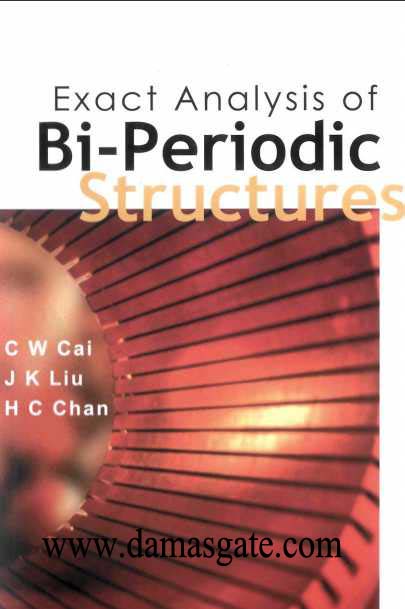Exact Analysis of Biperiodic structures

PREFACE
In the book "Exact Analysis of Structures with Periodicity using UTransformation"
(World Scientific 1998), a comprehensive and systematic explanation has been given
on the U-transformation method, its background, physical meaning and mathematical
formulation. The book has demonstrated the application of the U-Transformation method
in the analyses of many different kinds of periodic structures. As it has been rightly
pointed out in the book, the method has a great potential for further development.
With the research efforts by the authors and others in recent years, important advancement
in the application of the U-transformation method has been made in the following
areas:
The static and dynamic analyses of bi-periodic structures
-Analysis of periodic systems with nonlinear disorder.
The static and dynamic analyses of bi-periodic structures When the typical substructure in a periodic structure is itself a periodic
structure, the original structure is classified as a bi-periodic structure: for example, a continuous truss supported on equidistant supports with multiple equal spans. As a singly periodic structure, the truss within each bay or span between two adjacent supports is a substructure. But there could be many degrees of freedom in such a substructure. If the U-transformation method is applied to analyze this structure as illustrated in the previous book, every uncoupled equation still contains many unknown variables, the number of which is equal to the number of degrees of freedom in each substructure. Therefore, it is not possible to obtain the explicit exact analytical solution yet. Though the substructure is periodic, it is not cyclic periodic. Hence, it is not possible to go any further to apply the same Utransformation
technique directly to uncouple the equations. One of the main
objectives for writing this new book is to show how to extend the U-transformation
technique to uncouple the two sets of unknown variables in a bi-periodic structure
to achieve an analytical exact solution. Through an example consisting of a system of
masses and springs with bi-periodicity, this book presents a procedure on how to
apply the U-transformation technique twice to uncouple the unknowns and get an analytical solution.
The book also produces the static and dynamic analyses for certain engineering structures with bi-periodic properties.
These include continuous truss with any number of spans, cable network and grillwork on supports with periodicity,
and grillwork with periodic stiffening members or equidistant line supports. Explicit exact solutions are given for
these examples. The availability of these exact solutions not only helps the checking of the convergence and accuracy
of the numerical solutions for these structures, but also provides a basis for the
optimization design for these types of structures. It is envisaged that there may be a great prospect for the application of this technique in engineering.
Analysis of periodic systems with nonlinear disorder The study on the force vibration and localized mode shape of periodic systems
with nonlinear disorder is yet another research area that has attained considerable success by the application of the U-transformation method. The localization of the mode shape of nearly periodic systems has been a research topic attracting enormous attention and concern in the past decade. In the same way, localization problem also exists in periodic systems with nonlinear disorder. This book illustrates the analytical approach and procedure for these problems together with the results.
It looks that there are big differences in the physical and mechanical meaning of the problems in the above-mentioned two areas. But as a matter of fact there are similarities in the approaches to their analyses. It is appropriate to present them all together in this book. They are both good examples of the amazing successful application of the U-transformation method.
The advantage of applying the U-transformation method is to make it possible for the linear simultaneous equations, either algebraic or differential equations, with cyclic periodicity to uncouple. The first chapter in this book will provide a rigorous proof for this significant statement and give the form of the uncoupled equations. The result will be used in the procedure to obtain the solutions for the example problems in this book.
Many achievements in this new book are new results that have just appeared in international journals for the first time together with some which have not been published before. This book can be treated as an extension of the previous book "Exact Analysis of Structures with Periodicity using U-Transformation" with the latest advancement and development in the subject. Nevertheless, sufficient details and explanations have been given in this book to make it a new reference book on its own. However, it will be helpful if readers of this book have obtained some ideas of the mathematical procedures and the applications of the U-transformation method from the previous book.
Prof. H.C. Chan
Oct. 30, 2001
Download
http://s18.alxa.net/s18/srvs2/01/Exa...structures.rar